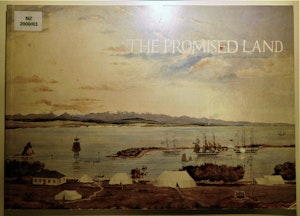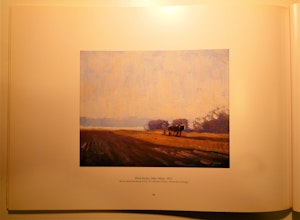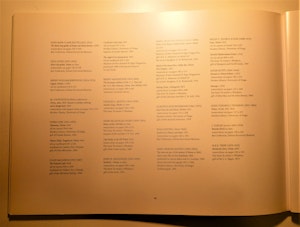Date
19 December, 1999
— 4 June, 2000
Venue
The Suter Te Aratoi o Whakatū
Location
Nelson, New Zealand
This was one of the three opening suites of exhibitions that marked the re-opening of the gallery after redevelopment and explored Nelson’s history as a haven for art.
Excerpt from 'Modern Arrivals' by William McAloon, The Promised Land: Art in Nelson from Tasman to Today exhibition publication, pp 12-13:
"Another arrival in the region who would be even more influential on Woollaston, was Flora Scales. Born in Lower Hutt, she departed for England in 1908 where she spent four years studying animal painting under Royal Academician Frank Calderon. It is tempting to assume that her encounter with Roger Fry's exhibition of the post-Impressionists at London's Grafton Galleries in 1910 stimulated her towards her future direction, but Scales's absorption of such influences was a little way off yet. The First World War brought her back to New Zealand and to Nelson, where her mother was running an orchard. Outdoor subjects particularly appealed to her, thanks to the influence of Wellington's Academy Sketch Club and Stoke, Nelson [BC013] from 1922 (page 38) shows her application of Calderon's tuition to these. By 1928, however, she was ready to leave again, in search of new ideas about art.
The new ideas about art that Flora Scales sought in Europe would have a profound impact on the work of several artists in the Nelson region, and ultimately on New Zealand's art history.
Arriving in Paris in 1928 Scales studied with the cubist Andre Lhote before moving to Munich to attend the prestigious Hans Hofmann school. Hofmann had fled the Nazis by this time, but his successor Edmund Kinzinger closely followed his principles.
At the Lhote Academy, Scales learned her modernist principles well: 'Do not think of the proportions but of the directions', she recorded in her notes. 'Build your house before you furnish it. 'Do not say "this is a woman or a model," but these are lines, rounds, cylinders, etc.'54 To this she added the experience of the Hofmann school. As Anne Kirker summarises, teaching there was based on the idea 'that a creative process lies not in imitating nature but paralleling nature. A picture should be expressive and live according to its own rules.'55 Perspective, the Hofmann school taught, was the fatal inheritance of the Renaissance. This understanding necessitated a new analytical approach – looking for squares and diagonals in the Old Masters – one adjoined to a profound sense of the possibilities afforded by colour: 'You cannot use colour as colour and as value at the same time – must get contrast in colour only',56 Scales wrote in her notes.
Scales's Mediterranean Village [BC016], painted on a school excursion to St Tropez, shows the application of those theories. Taking a high viewpoint – 'always draw from a position above your subject', she later told Woollaston57 – it presents the village and surrounding landscape in layers of flattened planes. 'Tilt the planes up', she explained 'and make them closer to the picture plane.' In doing so, Scales offsets the rectangularity of canvas against the diagonals of her composition, using the interrelationships of heightened colours to bring the painting towards equilibrium.
It was works such as this that drew the attention of Woollaston in 1934, when he saw them at the home of Scales's sister in Christchurch. Returning to Nelson he sought out Scales. She was by then living at Tahunanui, having departed Germany with the impending rise of the Nazis, and she reluctantly agreed to meet him. Woollaston recalled that he “earnestly begged to be taken as a serious pupil for a season [...]. My eager homage was accepted at first and I was admitted, though a little nervously I felt: but before long the inconvenience of my visits was made plain to me even in my importunate state. Perhaps I distracted her from her own work [...]”58
Scales's own painting was indeed interrupted, not just by Woollaston but by Nelson and New Zealand in general. Invited by the younger artist to exhibit at the Suter Art Society, her works were found to be shocking – 'like frying pans'.59
Frustrated by the isolation of her situation and a similar lack of comprehension of her work following exhibitions in Wellington and Christchurch, she left for Europe again late in 1935 or early 1936 to continue what she called the 'endless search for improvement' in her work.60
The five lessons that Woollaston received – perhaps more in the order of conversations – proved decisive. 'I was able to start painting my own thing after I met Flora Scales – she opened the gates,' he later recalled. 'Meeting her was the biggest event in my artistic life – she offered direction for thinking.'61
Footnotes
54 Anne Kirker, New Zealand Women Artists: A survey of 150 years, Sydney: Craftsman House, 1990, pp69-70
55 Kirker p70
56 Kirker p70
57 Toss Woollaston, Sage Tea: An autobiography, Auckland: Collins, 1980 p247
58 Toss Woollaston, The Far-away Hills: A meditation on New Zealand Landscape, Auckland: Auckland Gallery Associates, 1962, p36
59 The Far-away Hills p37
60 Barbi de Lange “Flora Scales The Woman and Her Work”, Art New Zealand No37 Summer 1985-6, p48
61 Quoted in Gregory O’Brien, Lands and Deeds: Profiles of Contemporary New Zealand painters, Auckland: Godwit, 1996, p197"
![Untitled [Stoke, Nelson] image](https://florascales.imgix.net/public/-022-img-BC013-74-158-HC.jpg?ixlib=js-3.8.0&auto=format&w=300)
![Untitled [Mediterranean Scene] 1 image](https://florascales.imgix.net/TimCuff-Flora-Scales02-copy-no-frame.jpg?ixlib=js-3.8.0&auto=format&w=300)






